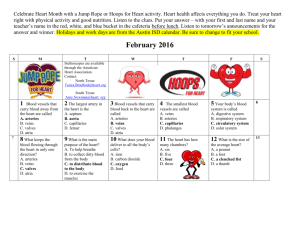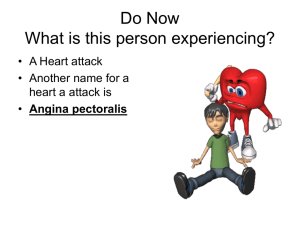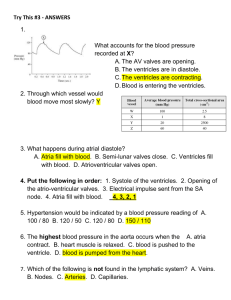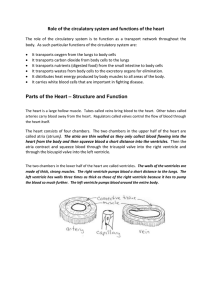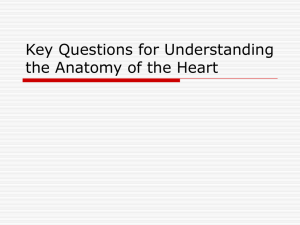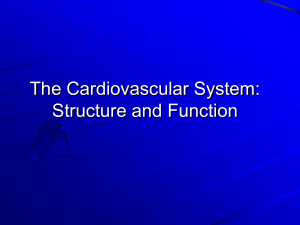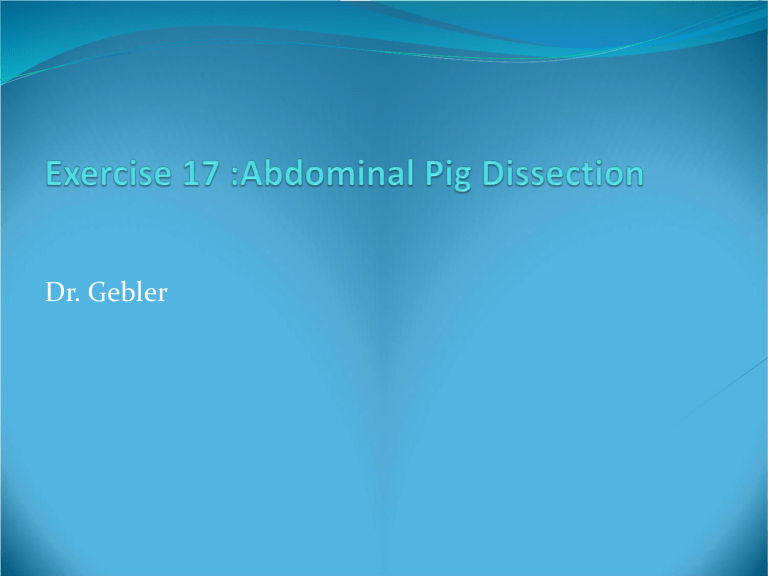
Dr. Gebler Dr. Glenn F. Gebler Heart The heart has 4 chambers Right atrium and left atrium (atria) Right and left ventricles Structure of the Heart The heart has four chambers The upper chambers are called atria right atrium and left atrium Atria have thin walls They receive blood from the veins They send blood to the ventricles The lower chambers are called ventricles Ventricles are thick walled and muscular They pump blood from the heart to the arteries The Heart is 2 Separate Pumps Housed in One Organ The right and left sides are separated by a wall (septum) The right side of the heart sends blood to the lungs; pulmonary circuit The left side sends blood to the body tissues; systemic circuit Valves keep blood flowing in the forward direction; valves between the atria and ventricles of each side; prevent backflow Valves Keep blood flowing in one direction Between the atrium and ventricle on each side Atrioventricular (AV) valves Tricuspid Bicuspid Valves between the ventricle and the artery of each side Semilunar valves Activity 1 Color mindfully the path that blood takes through the heart and through the body. Pay attention to the pulmonary and systemic circuits and understand how and where blood is oxygenated. Red blood cells pass through the lungs and pick up oxygen; oxygen binds to iron atoms in the Hb molecule Act. 1 and 2 Blood Pathway Flow Follow the blood flow: Vena cava-R atrium- R Ventricle-pump to the lungs(pulmonary artery)- coming back (pulmonary vein)- L atrium- -Lventricle- pump to the body (aorta)- come back to the vena cava The valves keep blood flowing one way- a heart murmur is when the valves fail to close properly and backflow occurs. The Septum that divides the 2 halves of the heart keep deoxygenated blood from mixing with oxygenated blood Observe the coronary arteries and veins that feed the heart muscle Intrinsic System Timing of the heart beat begins with special pacemaker called sinoatrial (s-a) node SA node Atrioventricular node transmits the stimulus AV node to contract the ventricles AV bundle Atria contract together, then the Purkinje fibers ventricles contract together Lub sound is closing of the atrioventricular valves; dup sound is closing of the semilunar valves Heart Model Slides The following heart model slides are from an Anatomy and Physiology Text so there is more detail then you will be asked to know, just make sure you know the major blood vessels that we discussed in class. Blood Vessels: Pipes that Deliver the Blood Arteries carry blood away from the heart Arteries have thick, muscular walls Arteries carry blood under high pressure from the heart A thick layer of smooth muscle tissue allow arteries to regulate blood flow by changing the blood vessel diameter Dilate - enlarge the diameter Constrict - shrink the diameter Veins Veins carry blood toward the heart Blood in veins exerts less pressure than the blood that is found in arteries Blood loses most of its propulsive force after it circulates through the tissues; blood is only able to return to the heart because of the action of skeletal muscles Lower strength Expandable Holds large volumes of blood Blood Pressure Activity 3 Force exerted by the blood against the arteries and vessel walls. As the heart pumps it pushes blood into the vessels under pressure Systolic pressure Ventricular contraction- the force of the heart beat surging blood into the vessels Diastolic pressure Ventricles relax between beats. Activity 3 As your “blood” flows through the “arteries”, what happens to flow rate as the diameter decreases? It takes longer for your “blood” to flow out of the “heart”. To compensate for a decreased diameter vessel what would your heart do to compensate to maintain the blood flow rate? The heart would have to pump harder and faster to maintain the same rate of blood flow. This creates more strain and stress on the heart. Blood Pressure Blood Pressure – What does it tell us? Measured in millimeters of mercury (mm Hg) and shown as a fraction of systolic/diastolic Normal BP 120/80 Hypertension – high blood pressure Resting systole > 140, diastole > 90 High BP shows up earlier and is more severe in African Americans than in other populations- more than half of all Americans over 65 have HBP Activity 4: Health Risks Plaque atherosclerosis -Narrowing the vessel diameter and decreasing amount of blood to flow through and increases risk of heart attacks Deposits Cholesterol, LDL, and other fats collect along with calcium cause vessel walls to lose their elasticity. Prevent them from adjusting as needed. Atherosclerosis and Hypertension Atherosclerosis and hypertension may cause heart attack or stroke – major underlying cause Atherosclerosis Artery interior narrows because of lipid deposition and inflammation LDLs deposit cholesterol; HDLs remove it Fatty Plaques Cause inflammation in the artery walls Can rupture and spill fatty contents in the the bloodstream This floating fatty debris can lead to blood clots Blood clots lead to heart attack and stroke. Narrowed blood vessels lead to Hypertension Chronically high blood pressure (above 140/90) Atherosclerotic Plaque cholesterol and fat deposits narrowed lumen of artery endothelium lumen of artery Cardiovascular Health Risks Take your quiz and find out what your risk factors are. Write down what you consider to be your greatest risk factor. What can you do to reduce your risk concerning this risk factor? What else can you do right now to improve your heart?

